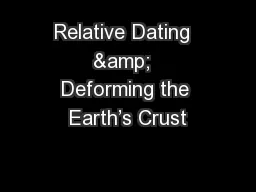

Folds Faults and Deformities OH MY Uniformitarianism Geologic processes that occurred in the past can be explained by current geologic processes Erosion and weathering that happens today must have been the same millions of years ago ID: 718170
Download Presentation The PPT/PDF document "Relative Dating & Deforming the Ea..." is the property of its rightful owner. Permission is granted to download and print the materials on this web site for personal, non-commercial use only, and to display it on your personal computer provided you do not modify the materials and that you retain all copyright notices contained in the materials. By downloading content from our website, you accept the terms of this agreement.
Slide1
Relative Dating & Deforming the Earth’s Crust
Folds, Faults and Deformities…
OH MY!!Slide2
UniformitarianismGeologic processes that occurred in the past can be explained by current geologic processes
Erosion and weathering that happens today must have been the same millions of years ago
Very slow, gradual, predictable process
Is this the correct principle?Slide3
CatastrophismGeologic change happens suddenly
Mountains, canyons and oceans formed during rare events
These rare events are called catastrophes
Up until the mid-1800’s, this was the accepted principle
Why was this the accepted principle?Slide4
Modern Geology
Uniformitarianism
Catastrophism
Can
geologic processes take a very long time? (think Tectonic Plates, mountains growing)
YES!
Mountains
forming/growing
Grand Canyon forming from erosion
Moving of
the continents
Can events happen very quickly?
(Think meteor causing dinosaur extinction)
YES!
Large Volcanic eruptions forming islands and causing extinctions
Meteor strikes creating craters and causing extinctions
Earthquakes, Tsunamis,
etc
…Slide5
Relative DatingRelative Dating – a method used to determine whether an object or event is older or younger than another object or event
Who is Older or Younger?Slide6
Absolute DatingAbsolute Dating – any method used to determine the age of an event or object in numbersCertain molecules called
Isotopes
decay over time
Isotope
– An atom that has the same number of protons, but a different number of
neutrons
We can use this decay to measure how old something is (rocks, fossils,
etc
…)
Half-life
– the amount of time it takes for half of a radioactive substance to decaySlide7
DisturbancesUnfortunately not all rock layers are laid out perfectly. Some things that can make things more difficult are…
Unconformity –
missing part of a geologic column
Missing rock layer(s) due to either
Erosion
or
Non-deposition
Deformations
– Altering of rock layers after they are laid down, but not removing themSlide8
DeformationsSlide9
DeformationsTectonic plates move, causing stress to build up in the lithosphere
Stress = force (three types)
Compression = squeeze together
Tension = stretch apart
Shearing = sliding past
Stress from tectonic plates cause rock layers in the lithosphere to changeSlide10
Folding
Definition: bending rock layers due to stress
Older rock starts on bottom
Anticline = upward arch (looks like an
A
)
Syncline = downward, U shaped (think sink)Slide11
SYNCLINE
ANTICLINESlide12
Folding
Folds can be large or small
Some measured in kilometers or centimetersSlide13
MONOCLINESlide14Slide15Slide16Slide17
Faults Definition: surface along which rocks break and slide past each other
Can be seen on the earth’s surface
Usually have a
Hanging wall
and
FootwallSlide18
Type of Stress?Which wall falls down?
Are rock layers disturbed?Slide19
Type of Stress?
Which wall falls down?
Are rock layers disturbed?Slide20
Type of Stress?
Which wall falls down?
Are rock layers disturbed?Slide21
Relative DatingFaults, Unconformities and Deformations raise a very important problem…Rock layers aren’t always perfect
So what do we do when rock layers aren’t perfect?
What happens when they look more like…Slide22
This. How do we find Relative Age?Slide23
Relative DatingOne way scientists calculate relative age is by using a set of rulesSuperposition – if undisturbed, rock layers will always be older as you go down (youngest on top)
Original Horizontality
– Layers of rock are always formed in relatively even horizontal layers
Cross-Cutting Rule
– if there is a fault cutting through layers of rock, the rock must be
older
Deformation Rule
– if there is a deformation (fold, tilt, intrusion) the rock that is deformed must be
olderSlide24
How do we find Relative Age?Slide25
Relative DatingAnother way geologists can figure out disturbed layers of rock is with the Geologic ColumnGeologic Column
– a complete set of the rock layers with all known fossils and layers in their proper order
Geologic Columns are used to find
Unconformities
When a layer of rock is missing from
Erosion
or
Non-Deposition
the geologic column can tell geologists what SHOULD be thereSlide26Slide27
Which layers are missing from the second outcropping?